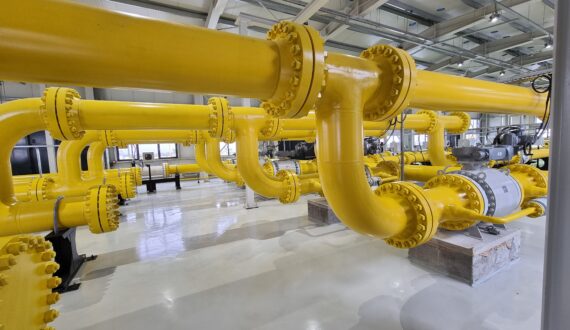Photovoltaic systems are not only used for large buildings or industrial halls, as we are tempted to believe. The applications of photovoltaic systems are multiple in areas where we would not expect.
Photovoltaic applications are numerous and advanced research in the field makes it possible to approach an increasing percentage of energy consumption from renewable sources so that we can save from the limited resources of the planet and ensure the continuity of life on it.
As it said in a previous article about photovoltaic , a photovoltaic system or a solar photovoltaic system is a power system designed to provide usable solar energy through photovoltaic panels. It consists of an arrangement of several components, including solar panels to absorb and directly convert sunlight into electricity, a solar inverter to change the electric current from direct current to alternating current, as well as mounting, wiring and other electrical accessories. . Photovoltaic systems range from small systems, mounted on the roof or integrated in buildings, with capacities from a few tens of kilowatts to large power stations of hundreds of megawatts. Nowadays, most photovoltaic systems are connected to the grid, while stand-alone systems represent only a small part of the market.
Photovoltaic arrays
 Photovoltaic arrays are often associated with buildings: either integrated in or mounted on them, or mounted nearby on the ground. Roof-mounted photovoltaic systems are most often found in existing buildings, usually mounted on top of the roof structure or on existing walls. Alternatively, an array can be located separately from the building, but connected by cable to provide power to the building.
Photovoltaic arrays are often associated with buildings: either integrated in or mounted on them, or mounted nearby on the ground. Roof-mounted photovoltaic systems are most often found in existing buildings, usually mounted on top of the roof structure or on existing walls. Alternatively, an array can be located separately from the building, but connected by cable to provide power to the building.
Photovoltaics integrated in buildings are usually those incorporated on the roof or walls of new domestic and industrial buildings, as the main or auxiliary source of electricity.
Provided there is an open gap in which air can circulate, roof-mounted solar panels can provide a passive cooling effect on buildings during the day and also retain the heat accumulated at night. Typically, residential roof systems have small capacities of about 5-10 kW, while commercial roof systems often amount to a few hundred kW.
Although roof systems are much smaller than useful power plants, they account for most of the installed capacity worldwide.
Photovoltaic concentrators

Photovoltaic concentrators (CPVs) are photovoltaic technologies that, unlike conventional flat-plate photovoltaic systems, use curved lenses and mirrors to focus sunlight on small but highly efficient, multi-junction (MJ) solar cells. In addition, CPV systems often use solar trackers and sometimes a cooling system to increase their efficiency. Continuous research and development is rapidly increasing competitiveness in the utility scale segment and in areas with high solar insulation.
Hybrid thermal photovoltaic solar collectors
Hybrid thermal photovoltaic solar collectors (PVT) are systems that convert solar radiation into thermal and electrical energy. These systems combine a solar photovoltaic cell, which converts sunlight into electricity, with a solar thermal collector, which captures the remaining energy and removes used heat from the photovoltaic module. Capturing both electricity and heat allows these devices to have a higher level of exergence and thus be more energy efficient in general than solar PV or solar thermal.
Photovoltaic power plants or solar farms
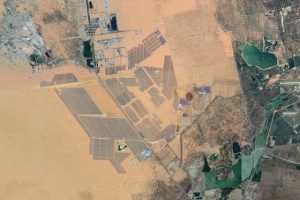
Many large-scale solar farms have been built around the world. Tengger Solar Park Desert is the largest solar farm built to date. Located in the Tengger Desert of China, the farm occupies only 3.25% of the arid land in the region. It may not look big, but it is actually over 10 times larger than New York’s Central Park and is capable of producing 1.5 Gigabytes of power, rivaling its capacity to most nuclear power plants. With plenty of space to expand, Tengger is expected to be a top solar power producer for years to come.
The second largest solar farm in the world is Bhadla Solar Park, which produced 1,365 MW in 2018. The park is expanding rapidly and plans to produce another 880 megawatts by March 2019. Once it reaches full capacity, Bhadla will claim the title of the largest solar installation in the world and help India get closer to its goal of gets 17% of its energy from solar energy.
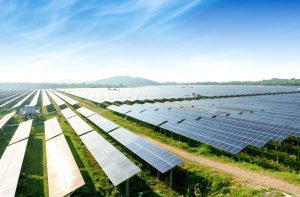
Many solar farms around the world are integrated with agriculture and some use innovative solar tracking systems that track the daily path of the sun in the sky to generate more electricity than conventional fixed systems. There are no fuel costs or emissions during plant operation.
Rural electrification
Developing countries where many villages are often more than five kilometers away from the grid energy are increasingly using photovoltaics. In remote locations in India, a rural lighting program has provided solar LED lighting to replace kerosene lamps. The solar lamps have been sold at the cost of supplying kerosene for several months. Cuba is working to provide solar energy for non-grid areas.
Stand-alone systems
Until a decade ago, photovoltaics were frequently used for power computers and innovative devices. Improvements in integrated circuits and low-power liquid crystal displays make it possible to power such devices for several years between two battery changes.
In contrast, fixed devices remotely powered by solar energy have seen increasing use, especially in locations where the costs of connecting to the electricity grid are prohibitive. Such applications include solar lamps, water pumps, parking meters, emergency telephones, garbage compactors, temporary traffic signs, charging stations and remote guard stations and signals.
Floating solar
Another variant of solar parks are floating solariums. If there is a limitation of the soil, there is the possibility of building photovoltaic parks on the water. In May 2008, Far Niente Winery in Oakville, CA pioneered the world’s first “floatovoltaic” system by installing 994 photovoltaic solar panels on 130 pontoons and floating them in the winery’s irrigation basin. The floating system generates about 477 kW of peak and when combined with a series of cells located adjacent to the pond is able to fully compensate for the electricity consumption of the winery.
The main advantage of a floating system is that it avoids the need to sacrifice a valuable area of land that could be used for another purpose. In the case of Far Niente Winery, the floating system saved three-quarters of an acre that would have been needed for a land system. That area of land can be used instead for agriculture.
Another benefit of a floating solar system is that the panels are kept at a lower temperature than on land, which leads to a higher efficiency of solar energy conversion. Floating panels also reduce the amount of water lost through evaporation and inhibit the growth of algae.
 Europe’s largest floating photovoltaic park is now mounted on London’s Queen Elizabeth II water tank. The work is part of Thames Water’s ambitious operation to produce at least a third of its energy by 2020. More than 23,000 photovoltaic panels will be installed on the surface of the water tank, which is not used in any way. The floating pontoon will cover one-tenth of the tank’s surface, the equivalent of eight Wembley stadiums. The renewable energy produced will be used to power the nearby water treatment plant and will have a capacity of 6.3 MW. Specialists expect the network to produce 5.8 million kWh in the first year, the equivalent of annual consumption of about 1,800 households.
Europe’s largest floating photovoltaic park is now mounted on London’s Queen Elizabeth II water tank. The work is part of Thames Water’s ambitious operation to produce at least a third of its energy by 2020. More than 23,000 photovoltaic panels will be installed on the surface of the water tank, which is not used in any way. The floating pontoon will cover one-tenth of the tank’s surface, the equivalent of eight Wembley stadiums. The renewable energy produced will be used to power the nearby water treatment plant and will have a capacity of 6.3 MW. Specialists expect the network to produce 5.8 million kWh in the first year, the equivalent of annual consumption of about 1,800 households.
Transportation photovoltaic applications
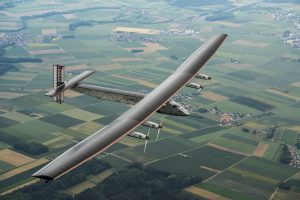
Photovoltaics are increasingly used to provide auxiliary energy in boats and cars. Some cars are equipped with solar-powered air conditioning to limit indoor temperatures on hot days. An autonomous solar vehicle has limited power and utility, but an electric vehicle charged with solar energy allows the use of solar energy for transportation.
The Swiss solar aircraft, Solar Impulse 2, obtained the longest non-stop solo flight in history and completed the first solar-powered aerial circumnavigation of 2016.
Telecommunications and signaling
Photovoltaic solar power is ideal for telecommunications applications, such as local telephone, radio and television services and other forms of electronic communications connections. This is because in most telecommunications applications, storage batteries are already in use and the electrical system is practically DC. On hilly and mountainous terrain, radio and TV signals may not reach because they are blocked or reflected back due to the undulating terrain. In these locations, low power transmitters (LPT) are installed to receive and retransmit the signal to the local population.
Spacecraft applications
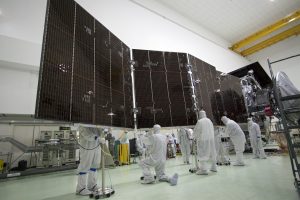 Solar panels on spacecraft are usually the only source of energy to run sensors, active heating and cooling, and communications. A battery stores this energy for use when the solar panels are in the shade. In some, power is also used to propel the spacecraft – electric propulsion. Spacecraft have been one of the oldest applications of photovoltaics, starting with the silicon solar cells used on the Vanguard 1 satellite, launched by the US in 1958. Since then, solar energy has been used in missions between the MESSENGER spacecraft and Mercury. in the solar system, at the Juno probe to Jupiter. The largest system of solar energy thrown into space is the electrical system of the International Space Station. To increase the power generated per kilogram, typical solar panels for spacecraft use high-efficiency, high-efficiency rectangular solar cells packed in gallium arsenide (GaAs) and other semiconductor materials.
Solar panels on spacecraft are usually the only source of energy to run sensors, active heating and cooling, and communications. A battery stores this energy for use when the solar panels are in the shade. In some, power is also used to propel the spacecraft – electric propulsion. Spacecraft have been one of the oldest applications of photovoltaics, starting with the silicon solar cells used on the Vanguard 1 satellite, launched by the US in 1958. Since then, solar energy has been used in missions between the MESSENGER spacecraft and Mercury. in the solar system, at the Juno probe to Jupiter. The largest system of solar energy thrown into space is the electrical system of the International Space Station. To increase the power generated per kilogram, typical solar panels for spacecraft use high-efficiency, high-efficiency rectangular solar cells packed in gallium arsenide (GaAs) and other semiconductor materials.
Sources: www.wikipedia.org www.green-report.ro www.stiintasitehnica.ro – photo floating solar Europa www.power-technology.com – photo Solar Impulse 2 www.nasa.gov – photo spacecraft applications





